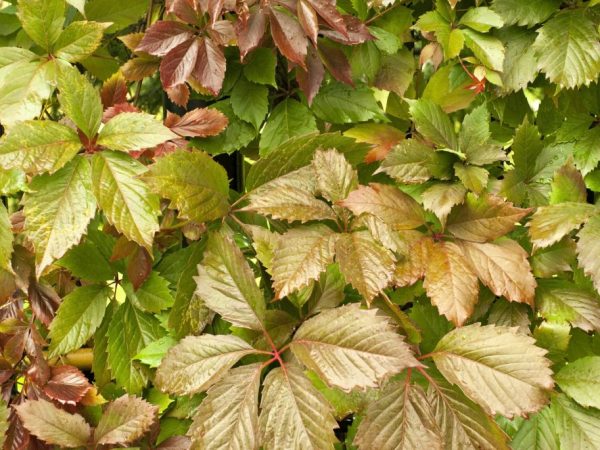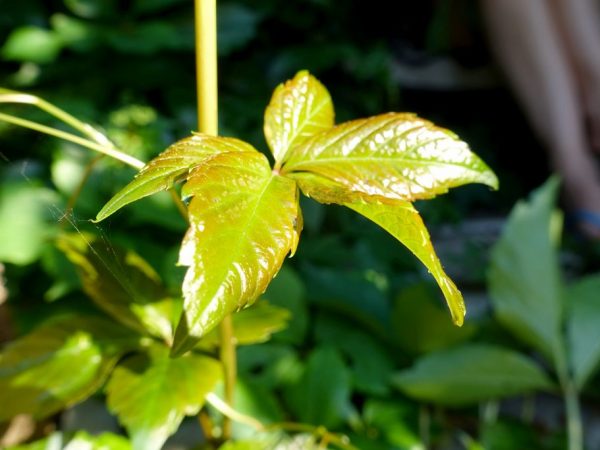Growing Maiden Grapes
Frost-hardy, attractive outwardly Maiden grapes (Parthenocissus) will decorate any garden, add zest to the landscape design. It is represented by several types.

Growing Maiden Grapes
General characteristics
The maiden grape or parthenocissus is a wild grape found in the Himalayas, USA and Asia. Received the name from the Greek words, translated meaning: "ivy" and "virgin". It is a self-pollinated species.
Parthenocissus grows with a dense soft cover, climbing onto supports. It is a powerful vine. Individual branches reach 18 m in length. The average length is 10 m. The branches are ligneous, dense in structure. Liana easily rises to any height on vertical supports.
Without formative pruning, the vine grows vertically and horizontally. Shoots release roots. The shrub is densely covered with foliage. Each variety has its own unique shape and structure of the leaf plate. The color changes depending on the season:
- emerald in spring and summer;
- autumn purple.
Blooms from June to August. Flowers are poorly distinguishable against the background of bright green foliage. In the fall, dark purple, small berries appear, and the leaves turn red.
Girly grapes are used in landscaping, they are not edible. It grows on all types of soil, reacts well to nitrogenous fertilizers.
Varieties
Maiden grapes are of several types: Five-leafed (variegated), Three-leafed, Attached, Ivy or tri-pointed, Variegated.
In total, there are about 20 species, but all the varieties of maiden grapes have found application in the regions of our country: Virgin and Trinity. Virginian began to be used 4-5 centuries ago. Plant bonus - high growth rate. Within a year you will enjoy the shade in the grape-woven gazebo.
Five-leafed has a structure different from other types. The sheet is divided into 5 parts. In the middle of summer, it throws out beautiful white flowers. It is poisonous, so you can't eat it. Natural reproduction of seeds is carried out by eating fruits by birds and rooting of cuttings.
Three-leafed began to be bred in China. There are houses completely entwined with grapevines. It is used in the southern regions of the country. The leaves have 3 branches.
Ivy, growing in the country or grown at home, is represented by the following varieties: Engelman and Koktebel grapes. Plants are distinguished by a small length of lianas up to 4 m. The leaves have a palmate-complex structure.
Frost-resistant varieties
Certain varieties of Virginian grapes withstand the winter:
- Old;
- Yellow wall;
- Muroroom;
- Serenade.
Shovers, Veitchi, Yellow loach, Troki do not tolerate winter well.
Landing
The parthenocissus family is classified as an aggressive species. They grow rapidly and can destroy any other culture that grows near them. Consider this fact when determining the location.Liana grows quickly and moves along the fence to nearby sites.
Maiden grape is a plant that takes root faster in southeastern areas. Under the bright sun, the liana of the maiden grape develops large juicy foliage. Parthenocissus are not picky about the composition of the soil.

Liana will become a garden decoration
Planting and caring for maiden grapes:
- dig up the area to a depth of 20 cm;
- eliminate weeds and roots;
- add 10 kg of compost, sand and 300 g of superphosphate per 1 sq. m;
- plant seedlings in pits 50x50.
Lay a layer of rubble at the bottom of the pit. Equip the landing site with a trellis. A hedge is planted at 1 m intervals between plants. For horizontal weaving, the interval is reduced to 0.6 m. When planting maiden grapes, seasonality is not critical. Saplings take root equally quickly in spring and autumn.
Care
The cultivation of maiden grapes involves increased year-round maintenance in the early stages of growth, until the crops develop a strong root system.
The main activities for the care of maiden grapes:
- fertilization;
- pruning;
- watering;
- weeding;
- hilling;
- garter.
As soon as the soil thaws, apply 50 g / m2 nitroammophos. Loosen the soil. After the opening of the first leaves, add top dressing to Kemir station wagon. Make the solution according to the manufacturer's description. Cut out shoots that are damaged in winter, growing improperly.
In the summer, during the rainy season, watering is not carried out. In drought - once every 7 days. Loosening should be done regularly after moistening the soil. Remove weeds. Fix the whips on a gazebo or other support, giving them the desired direction. Remove excess vines mercilessly.
Hilling is carried out several times over the summer to prevent exposing the roots. Prune dried, broken branches again in the fall. Collect the leaves and place them on the compost. Apply potassium-phosphorus fertilizers to the soil. Mulch the soil with straw. Cover with rags for the winter (the procedure is carried out only for young seedlings, up to 3 years old) so as not to freeze.
Reproduction
Ivy propagates by cuttings, seeds or cuttings. All methods are equally effective. Propagating the culture by cuttings, it is possible to completely preserve all parental properties. You can cut the shoots yourself or visit a nursery that sells zoned varieties. Select a shoot for the production of cuttings with a diameter of 5 mm.
The length of the shank is 15 cm. Leave 4-5 buds on each shank. Root the cuttings in a container of water or in a pot of soil. Cuttings are carried out in the spring. The shanks cut during the active growing season form roots faster. When rooting a cutting, make sure that 2 buds are under water (in the ground).
You need to plant the shanks at the moment the roots appear. After transplanting into open ground, monitor the humidity. Cuttings planted in a pot and transplanted into open ground a year later take root better, have greater endurance. Inoculation of the shanks is not required.
Seed propagation
In the climatic conditions of our country, seeds of the Virginian grapes ripen. Planting material will not sprout if it was harvested more than 12 months ago. Planting seeds involves mandatory stratification. Do it yourself at home.

The plant needs support
Stratification is the preliminary preparation of seeds, which makes it possible to harden the plants. Dip the seeds in cold water, then in a container of soil. Set aside the pots in a cold place for 2-3 days. After this period, you can sow seeds in the pot. The optimal planting depth is 1-2 cm.
The seeds in the container will germinate in a month. Red grapes grow quickly and look spectacular, purifying the atmosphere in the house, improving the indoor climate. You can grow seedlings in the house and leave a few twigs in the pot to decorate the interior. The main thing is to stop the growth point in time.By installing special supports, you will be able to grow your own living corner in your home.
Reproduction by layering
The easiest method to breed grapes. An adult liana weaves not only vertically, but also horizontally. Spreading to the sides, the vines scatter their branches and rooting takes place. Leave some 3-year-old shoots in the spring pruning season and pin them to the ground.
Sprinkle the branches on top with fertile soil. The next spring, after complete rooting has passed, you can cut off the layers from the mother specimen and transplant to the desired place.
Diseases and pests
Maiden grapes are resistant to the effects of insect parasites and diseases. Aphids appear occasionally. Pests will quickly leave the site if the plants are treated with soapy water. Other pests do not eat the plant.
White dew is a typical disease. The leaves are covered with a white bloom, curl and dry out. Eliminate the disease with fungicidal preparations.
Application in landscape design
Benefits that the grapes give girlish:
- medicinal properties are the ability to clean the air from toxins and create a good microclimate for recovery;
- sound insulation of the walls of the gazebo, house;
- sun protection;
- save him from the processes of decay and infection with a fungus, simplify the design of the summer cottage;
Girlish grapes will adorn any building, arch, balcony of a house or apartment. Liana has been living for over 20 years. Unpretentious in care, tolerates frost well. Wintering takes place successfully even in the coldest regions of our country. A climbing plant serves as a wall insulation in the autumn-winter period, if it is planted around buildings.
It is customary to plant thuja, fir, spruce and juniper near it. Clematis, together with the maiden grapes, make an incredible combination. Red grapes at the end of summer next to white clematis flowers look spectacular and romantic. With the help of two plants, you can make a piece of paradise out of your site.
Having planted a plant on the site, it is worth remembering its high aggressiveness towards other plants. Maiden grapes can tighten all the space occupied by cultivated, fruit plants and harm them. You can get rid of it only by using chemistry.
Conclusion
Maiden grapes in landscape design decorate walls, hills, purify the air in the backyard. Seedlings require careful maintenance only for the first 3 years. Then the parthenocissus freely provides itself with everything necessary due to the powerful root system.


